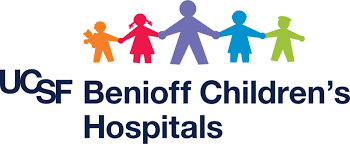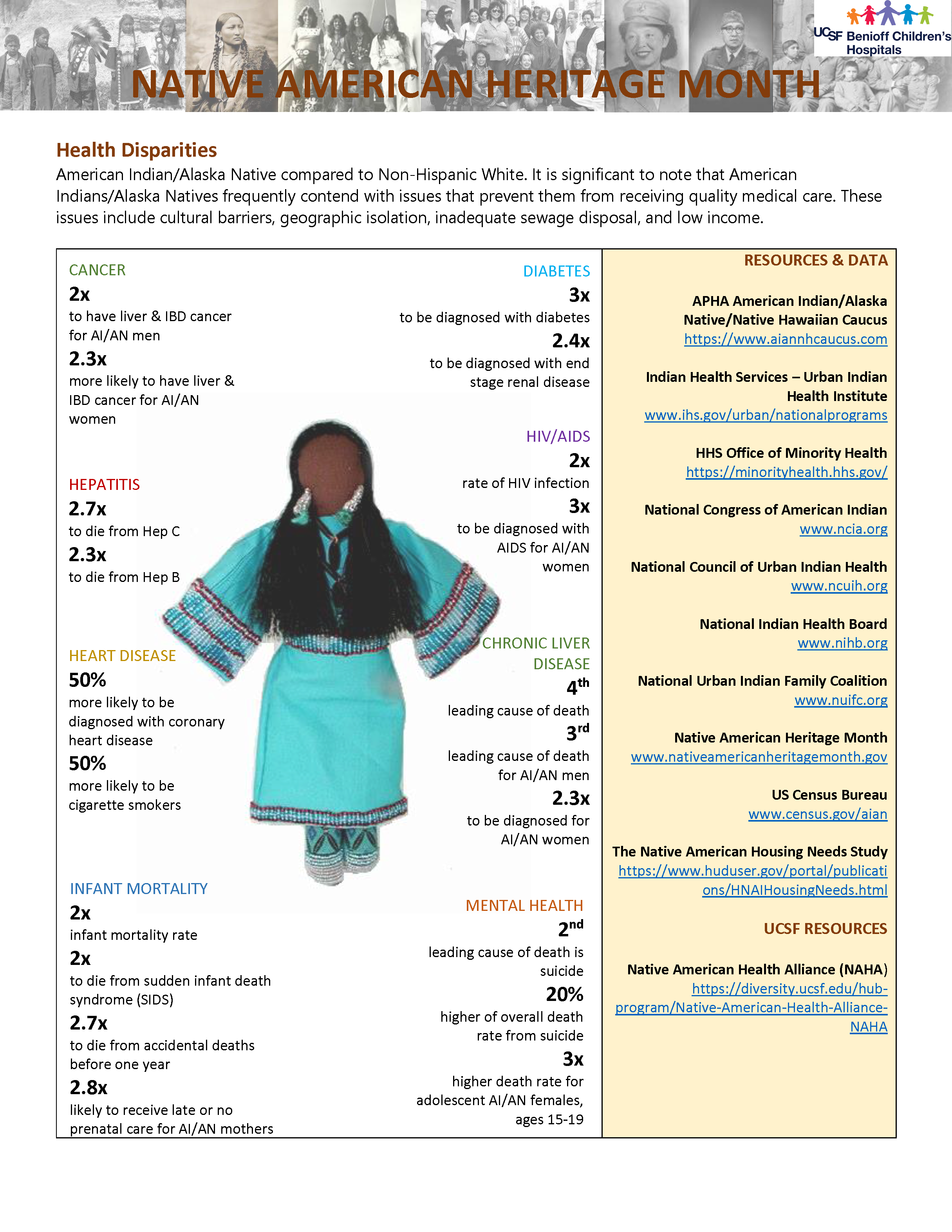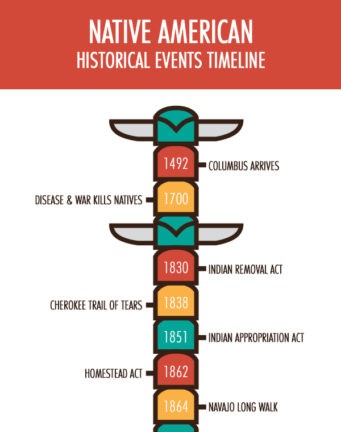Native American Heritage Month celebrates the rich and diverse cultures, traditions, and history and acknowledges the important contributions of American Indians and Alaska Natives in the United States. We encourage you to show your UCSF PRIDE by sharing your Indigenous/Native American heritage with your colleagues and friends. Here are a few ways you can share.
- Change your social media and Zoom profile picture to reflect your Native American/ Indigenous Heritage
- On Zoom use a virtual background showing your Indigenous/Native American Heritage (Bonus if the photo is one your took yourself)
- Share your pictures and/or short videos of yourself in cultural attire or engaging in a cultural activity. Send to [email protected].
- Add "Native American Heritage Month" and/or an image showing your Indigenous/Native American Heritage to your Email Signature

Fact Sheets and Infographics
Highlight: Francesca Vega, UCSF Vice Chancellor, Community and Government Relations

What is your role at UCSF?
I am the Vice Chancellor of Community & Government Relations, which is a new role for UCSF. In this capacity, I lead a team that generates support and facilitates dialogue between UCSF and local, state and federal entities. We also build and strengthen key relationships with the communities that UCSF serves and are often at the frontline of UCSF’s response to a wide range of political and policy issues.
What is your personal story? How did you get here?
How much time do we have?! Career-wise, I always saw a future in public policy or public-service but it wasn’t until I was in college that my passion for access to quality education started to define the path I would go on to pursue. I then had the opportunity to work for the late Assemblymember Marco Antonio Firebaugh who authored legislation, AB 540, that laid the foundation for our Dreamers and DACA students. Access to quality public education is a game changer and transformative, how it impacts people’s lives will always be incredibly inspiring to me. Working for the University of California and the California State University, has been a very natural fit for me—challenging at times but I have greatly appreciated being in environments where I’m surrounded by many equally passionate, value-driven individuals.
As someone who comes from indigenous – Choctaw Native American and French Creole mother and a Mexican-American father, what does Native American Heritage Month mean to you?
It means that I’m especially intentional when taking time to reflect on where I came from, what my family’s story and history contributed to the woman I am today and why it is more critical than ever to give back and support our most vulnerable communities. This is a month that I feel it is especially important to focus on gratitude.
What advice or life lessons can you impart to our BCH patients, especially those who are of Native American or Latinx heritage?
Be authentic and true to yourself, even when it is difficult or lonely. Confidence in who you are and the unique perspective you “bring to the table” are invaluable. Your spirit, values, personality, these are also critical components to how one leads and embraces leadership. I would also add, perhaps now more than ever, to patient with yourself. This is something I always need to remind myself but, with so many challenges and uncertainty, we must be patient with ourselves and try to take on one challenge at a time.
Fun Facts
Native Lands
This map shows you what Indigenous lands you're living on. The crowd-sourced, interactive website mapping traditional territories of Indigenous people, treaties and language has grown to become so much more. The map was created by Victor G. Temprano, a Canadian who was "born in traditional Katzie territory and raised in the Okanagan" and who began work on the project in 2015. It currently covers the USA, Canada, much of Mexico, Australia, South Africa, and expanding amounts of territory in South America.
History of the Emeryville Shellmound
The Emeryville Shellmound was a highly remarkable historic, cultural, and sacred site established by Ohlone Indians over centuries of use from 500 B.C. to approximately 1700 A.D. These people were among the earliest inhabitants of the region now known as the San Francisco Bay Area. They built their villages on the mound and buried their dead, creating, over the centuries, a sixty foot high mound with a diameter of about 350 feet. This significant site functioned holistically in both the secular and sacred realms, and as such, should not have been disturbed, but honored as a place set apart from the mundane world.
Muwekma Ohlone Tribe of the San Francisco Bay Area
The present-day Muwekma Ohlone Tribe is comprised of all of the known surviving American Indian lineages aboriginal to the San Francisco Bay region who trace their ancestry through the Missions Dolores, Santa Clara, and San Jose; and who were also members of the historic Federally Recognized Verona Band of Alameda County. The aboriginal homeland of the Muwekma Ohlone Tribe includes the following counties: San Francisco, San Mateo, most of Santa Clara, Alameda, Contra Costa, and portions of Napa, Santa Cruz, Solano and San Joaquin. This large contiguous geographical area, which historically crosscuts aboriginal linguistic and tribal boundaries, fell under the sphere of influence of the aforementioned three missions between 1776 and 1836. The missionization policies deployed by the Catholic Church and militarily supported by the Hispanic Empire, brought many distantly related, and in some cases, already inter-married tribal groups together at the missions.
Project 562
Created by Matika Wilbur, Project 562 is a multi-year national photography project dedicated to photographing over 562 federally recognized tribes in The United States resulting in an unprecedented repository of imagery and oral histories that accurately portrays contemporary Native Americans. This creative, consciousness-shifting work will be widely distributed through national curricula, artistic publications, exhibitions, and online portals.
Matika has visited members of over 300 sovereign nations throughout 40 states, from Tlingits in Alaska to the Pimas in Arizona, Pomos in California to Wampanoags on Cape Cod. Through her lens, we are able to see the diversity, vibrancy, and realness of Indian Country, and in seeing, challenge and surpass stereotypical representations and refresh the national conversation about contemporary Native America.
Native American Health Disparities
Native American Health Disparities Data
OMH - Native American Heritage Month
OMH Minority Population Profiles: American Indian/Alaska Native Health
CDC - Celebrate Native American Heritage Month
CDC MMWR: COVID-19 Among American Indian and Alaska Native Persons
CDC NCHS: Health of American Indian or Alaska Native Population
CDC NCHS: Health Disparities in HIV/AIDS, Viral Hepatitis, STDs, and TB
CDC Public Health Information for Tribes: Chronic Diseases
CDC Vital Signs: Native Americans with Diabetes
Indian Health Services (IHS) Indian Health Disparities Fact Sheet
U.S. National Library of Medicine, MedlinePlus - American Indian and Alaska Native Health
UCSF Battles COVID-19 in Navajo Nation
UCSF Health Care Workers to Serve in Navajo Nation by Scott Maier, April 22, 2020
UCSF Sends Second Wave of Health Workers to Navajo Nation by Nicholas Weiler, May 21, 2020
Lending a Hand in the Navajo Nation by Susan Godstone and Anny Brody Guy
Working Together - UCSF at Tséhoostsooi Medical Center
Resources and Publications
- CDC American Indians and Alaska Natives High Risk of Flu Complications Infographic
- CDC and Indian Country Working Together Booklet
- CDC Tribal Health
- CDC National Center for Chronic Disease Prevention and Health Promotion: Healthy Tribes
- CDC National Diabetes Prevention Program
- CDC Native Americans with Diabetes
- Indian Health Service (IHS)
- IHS Special Diabetes Program for Indians
- National Indian Health Board
- MedlinePlus American Indian and Alaska Native Health
- OMH Knowledge Center Online Catalog – AI/AN Health Resources
- SAMHSA Office of Tribal Affairs and Policy
- Urban Indian Health Institute
- USDA Tribal Programs and Services
- White House Initiative American Indian and Alaska Native Education
Articles
Native Americans: A Crisis in Health Equity by Mary Smith, American Bar Association




